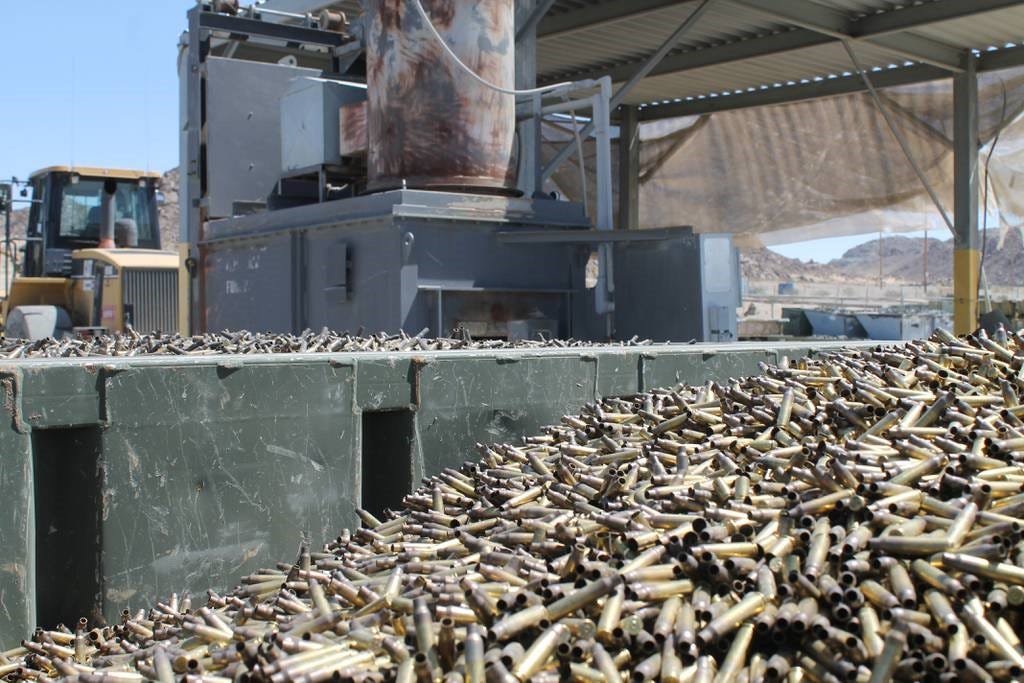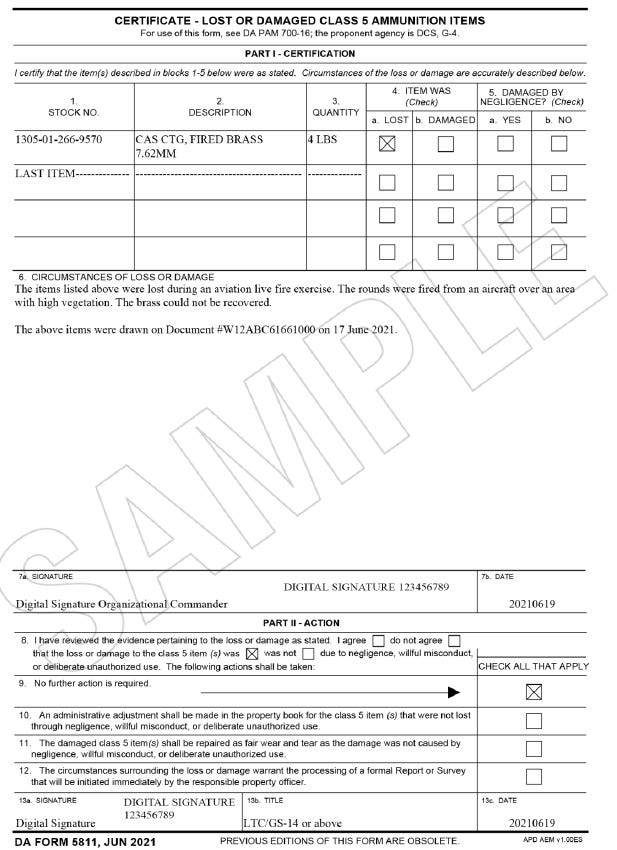Certificate for Lost or Damaged Class V (Ammunition) Items
The range residue processing center recycles thousands of pounds of bullet casings each year. In 2010, the center processed and sold 450 tons of aluminum, brass, and steel scrap metal.
It happens to every Soldier! Brass is often overlooked in the sand on firing lines, on the back of trucks, or somewhere in the grass. It is impossible to pick up every piece of brass in a training area. However, the US Army has a unique administrative solution regarding reconciling the ammunition supplies issued. It is far different from the other services in the Joint Force and possibly among other allied and partner nations. The solution is the Department of the Army (DA) Form 5811, titled Certificate - Lost or Damaged Class 5 Ammunition Items. It is a unique form that is often not fully understood by commanders or personnel responsible for processing them at ammunition supply points.
DA Form 5811
The DA Form 5811 is set by Army Regulation 700–28, and its use is administrated by the Department of the Army Pamphlet 700–16, Ammunition Management. The form has two sections;
Part I – Certification
Part II- Action
Soldiers can find the straightforward requirement for the form can be found in Army Regulation 700–28, which states the following;
“If the residue and live ammunition turn-in quantity is less than the quantity of the ammunition issued, the organization will generate DA Form 5811 with a detailed explanation of the circumstances of the loss. The first lieu-tenant colonel or civilian equivalent (general schedule (GS)-14) in the chain of command will determine whether the loss or damage is due to negligence and take the appropriate action, as indicated on DA Form 5811, prior to signing block 13a of DA Form 5811."
But as with anything, the details matter, and often, the circumstances play a significant role in how the form is completed. First, determining brass weight and the required amount to return is a contested issue.
Figure 1. DA Form 5811 (Certificate - Lost or Damaged Class 5 Ammunition Items)
Determining Brass Weight
Department of the Army Pamphlet 700–16, Appendix G Salvage and Residue Weights provide an example of full and partial residue returns. To determine brass weight from the quantity of live ammunition issued, multiply the number of live rounds by the weight factor (pounds) found in the brass conversion chart.
A user that is issued 39,875 rounds of 5.56 mm ammunition must return 538.3 pounds of brass (39,875 x 0.0135 = 538.3 pounds).
A user that is issued 39,875 rounds of 5.56 mm ammunition and turns in 19,875 rounds of live 5.56 mm ammunition must return 270 pounds of brass ((39,875 −19,875) x 0.0135 = 270 pounds).
The first question you may receive is, do I need to turn in everything? Do you allow for a certain percentage to be recovered? The short answer is no. In the first example above, 538.3 pounds of brass are required, no less. There must be a minimum of 538.3 pounds of brass; you can turn in more, but you will likely be short on a different document.
Circumstances of Loss or Damage (Part I)
Department of the Army Pamphlet 700–16 clarifies what action commanders must take to ensure the circumstances are valid and are provided for the reconciliation of documents. Specifically, that units must
“Make every effort to collect all residue for turn-in, even when the nature of the event prevents collection of all residue. Missing live ammunition requires action under AR 190–11. An AR 15–6 investigation will be initiated when a shortage of CAT I ammunition or CAT I residue occurs.
Commanders are required to initiate action and attach evidence of that action (for example, a copy of AR 15–6) when—
Turn-in action and all administrative requirements were completed after 5 working days following the event for which the ammunition was issued, and an extension was not granted due to abnormal circumstances.
The combined quantities of live ammunition and residue turned in are less than the quantities initially issued by the ASP and are not accounted for by the commander's statement.
Damage to live ammunition is from other than fair wear and tear.”
Part I, Certification, is completed by immediate commanders, (usually a Captain, the Company Commander) as they are "required to initiate action and attach evidence;" in the chain of command. The statement is usually a plausible scenario that is acceptable. Some cases are not so plausible, but that is upon the acceptance of the first lieutenant colonel (usually the battalion commander) in the chain of command.
Action (Part II)
One of the most misunderstood sections of the form is that of Part II- Action. Department of the Army Pamphlet 700–16 states that "Items required for turn-in with short quantities must have a valid DA Form 5811 (Certificate - Lost or Damaged Class 5 Ammunition Items) or other evidence of a pending investigation (see AR 700–28)." This adds to the confusion of what action must be taken in any out-the-ordinary situations. An AR 15–6 investigation is the default, but there are, in fact, three types of fact-finding or evidence-gathering procedures under Army Regulation (AR) 15–6 which are:
Preliminary inquiries,
Administrative investigations
Boards of officers.
Army Regulation (AR) 15–6 continues to describe a preliminary inquiry. Stating the following:
“A preliminary inquiry is a procedure used to ascertain the magnitude of a problem, to identify and interview witnesses, to summarize or record witnesses’ statements, to determine whether an investigation or board may be necessary, or to assist in determining the scope of a subsequent investigation. An appointing authority may conduct a preliminary inquiry personally, or may appoint an inquiry officer orally or in writing.”
Ultimately, the appointing authority of preliminary inquiries decides the action and where to place “Check All That Apply” on the DA Form 5811 (Certificate - Lost or Damaged Class 5 Ammunition Items).
Conclusion
The majority of lost or damaged Class V items are usually lost brass. But can include other residue, boxes, or ammunition cans that must be turned in. The most frequent conflict between units and ammunition supply points is under the category of "other than fair wear and tear." When inspectors believe that the damage was malicious and requires discussion between commanders to resolve. The DA Form 5811 (Certificate - Lost or Damaged Class 5 Ammunition Items) offers a quick way for commanders to understand the circumstances of lost material that they have responsibility for and are the only one with the authority to decide if the items have been truly lost or not negligently damaged.
References
Image. Marines make millions off ammo casings, bomb fragments, https://www.marinecorpstimes.com/news/your-marine-corps/2015/05/16/marines-make-millions-off-ammo-casings-bomb-fragments/
Army Regulation 15–6, Procedures for Administrative Investigations and Boards of Officers, https://armypubs.army.mil/epubs/DR_pubs/DR_a/pdf/web/r15_6.pdf
Army Regulation 700–28, Ammunition Management, https://armypubs.army.mil/epubs/DR_pubs/DR_a/ARN30988-AR_700-28-000-WEB-1.pdf
DA FORM 5811, JUN 2021, Certificate - Lost or Damaged Class 5 Ammunition Items
DA FORM 5692, Ammunition Consumption Certificate
PAM 700-16, Ammunition Management, https://armypubs.army.mil/epubs/DR_pubs/DR_a/ARN31667-PAM_700-16-000-WEB-1.pdf



